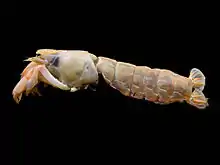Upogebia pugettensis
Upogebia pugettensis, also known as the blue mud shrimp, is a species of mud lobster from the West Coast of North America.[1]
| Upogebia pugettensis | |
|---|---|
 | |
| Upogebia deltaura, a related species | |
| Scientific classification | |
| Kingdom: | |
| Phylum: | |
| Subphylum: | |
| Class: | |
| Order: | |
| Family: | |
| Genus: | |
| Species: | U. pugettensis |
| Binomial name | |
| Upogebia pugettensis (Dana, 1852) | |
Description
Upogebia pugettensis has an elongated and broad abdomen, including a well development tail fin. The shrimp measure up to 11 cm long in adulthood. Its rostrum is hairy and includes 3 teeth. They eat detritus which they bring into their burrow using their pleopods. Upogebia pugettensis is the host of many parasites: Pseudopythina rugifera, Phyllodurus abdominalis, and Orthione griffenis.[1][2][3]
Distribution
Upogebia pugettensis is found from Valdez Narrows, Alaska, to Morro Bay, California. South of Morro Bay, U. macginitieorum, a very similar species to U. pugettensis, is found.[4]
Ecology
Upogebia pugettensis lives in Y or U shaped burrows (0.6m to 1.0m deep) that are located in inter-tidal mud flats. They usually live in pairs.[1][2]
Population decline
Upogebia pugettensis is currently facing a serious threat from the non-native isopod parasite Orthione griffenis (Markham, 2004). Female Upogebia pugettensis are infested with the parasite more than their male counterparts (80% compared to 57%). Female Orthione griffenis attach themselves to the gill of the shrimp. They then consume the blood of the host, which causes a metabolic burdening effect that greatly hampers reproductive ability. This has caused the decline.[2][5]
In 2017 the infestation was found to have extended into British Columbia.[6][7]
References
- "WoRMS - World Register of Marine Species - Upogebia pugettensis (Dana, 1852)". www.marinespecies.org. Retrieved February 7, 2020.
- "Upogebia pugettensis". inverts.wallawalla.edu. Retrieved February 7, 2020.
- "Marine Species Identification Portal : Blue mud shrimp - Upogebia pugettensis". species-identification.org. Retrieved February 7, 2020.
- "Upogebia pugettensis | Encyclopedia of Puget Sound". www.eopugetsound.org. Retrieved February 7, 2020.
- Dave Cowles. "Orthione griffenis". inverts.wallawalla.edu. Retrieved February 7, 2020.
- "A Mud Shrimp's Worst Nightmare - Hakai Institute".
- "Matthew Whalen et al, Poleward range expansion of invasive bopyrid isopod, Orthione griffenis Markham, 2004, confirmed by establishment in Central British Columbia, Canada, BioInvasions Records (2020). DOI: 10.3391/bir.2020.9.3.09".